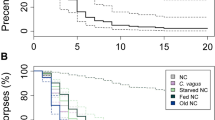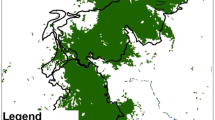Abstract
Necrophoresis (removal of nest-mate corpses) was studied in two Indian ant species, Camponotus compressus (fam. Formicinae) and Diacamma vagans (fam. Ponerinae), collected from suburbs of Calcutta (now Kolkata), India. Small groups of worker ants were maintained in formicaria in order to study “hard-wired” behaviour patterns in the absence of any stimulus from gynecoids, eggs, larvae etc. C. camponotus regularly showed a site specific disposal area (cemetery) for nest-mate corpses but they chose a preliminary and a second, a more permanent site which was shifted later while the primary site remained unaltered. In contrast, these ants formed no midden (a pile of refuse) but removed remnants of food only to slight distances in a random fashion and those refuse materials were never carried to the cemetery site. To our knowledge, the double cemetery site is a new record. D. vagans, on the other hand, established neither a cemetery nor a midden. They removed nest-mate corpses again and again to different directions and distances. As many as twelve removals of a single corpse were recorded in 48 hrs time period. Food remnants were removed to slight distances in different directions. Both the ant species treated differentially the nest-mate corpses and food refuse.
Similar content being viewed by others
References
Bingham, C.T. 1903. The Fauna of British India including Ceylone and Burma. Hymenoptera, Vol.II, Taylor and Francis, London.
Goestch, W. 1957. The Ants, University of Michigan Press, USA.
Hölldobler, B. and Wilson, E.O. 1990. The Ants, Springer Verlag, USA.
Howard, D.F., Tschinkel, W.R. 1976. Aspects of necrophoric behaviour in the red imported fire ant, Solenopsis invicta. Behaviour, 56: 158–180.
Moser, J.C. 1963. Content and structure of Atta texana nests in summer. Annals of the Entomological Society of America, 143: 1048–1049.
Rettenmeyer, C.W. 1963a. Behavioral studies of army ants. University of Kansas Science Bulletin, 44: 281–465.
Stahel, G., Geijskes, D. C. 1939. Ueber den Bau der Nester von Atta cephalotes L. und Atta sexdens L. (Hym. Formicidae). Revista de Entomologia 10: 27–78.
Tiwari, R. N. 1999. Taxonomic studies on ants of southern India (Insecta: Hymenoptera: Formicidae), Zoological Survey of India, Memoirs 18 No. 4, Calcutta, India.
Wheeler, W. M. 1926. Ants, their structure, development and behavior. Columbia University, USA.
Wilde, J. 1615. De Formica. Liber Unus. Amberg near Schonfeld, 108 p. (Original unavailable, seen in Hölldobler and Wilson, 1990).
Wilson, E. O., Durlach, N.I., Roth, L.M. 1958. Chemical Releasers of Necrophoric Behavior in Ants. Psyche 65: 108–114.
Wilson, E.O. 2006. An Interview in National Geographic Magazine, May 2006.
Author information
Authors and Affiliations
Corresponding authors
Rights and permissions
About this article
Cite this article
Banik, S., Biswas, S., Karmakar, R. et al. Necrophoresis in two Indian ant species, Camponotus compressus (Fabricius) and Diacamma vagans (Smith) (Insecta: Hymenoptera: Formicidae). Proc Zool Soc 63, 87–91 (2010). https://doi.org/10.1007/s12595-010-0012-6
Received:
Revised:
Accepted:
Published:
Issue Date:
DOI: https://doi.org/10.1007/s12595-010-0012-6




